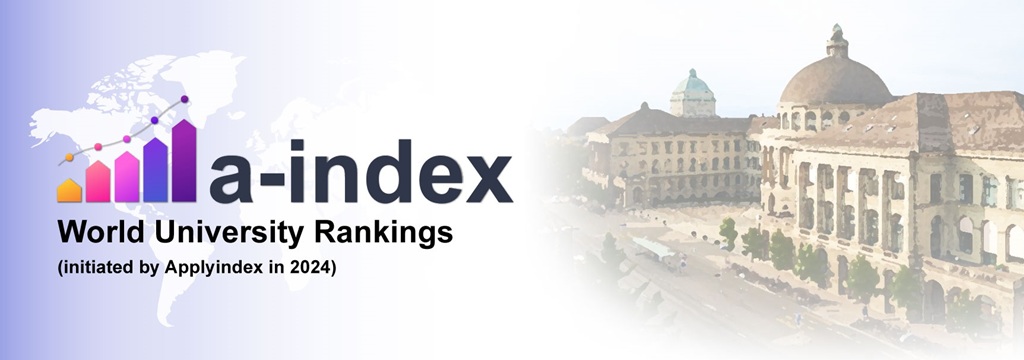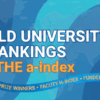
World University Rankings are among the primary tools students use when selecting universities for their desired degree levels. Popular and trusted ranking systems, such as QS, Times Higher Education (THE), ARWU, US News, and the AD Scientific Index, help applicants understand institutional strengths from multiple angles. These rankings are also widely referenced by government policymakers, university administrators, private-sector stakeholders in higher education, global media, and even students’ parents. Applyindex has introduced a new game-changing player to this landscape: the a-index World University Rankings. Each system uses distinct parameters, ranging from Nobel Prize winners and faculty h-index values to the likelihood of winning fully funded PhD positions, shaping the modern practice of international university evaluation.
a-index World University Rankings
The a-index World University Rankings offer a unique and applicant-focused approach by measuring how difficult it is to secure fully funded PhD positions at each university. Instead of relying on reputation surveys or citation volumes, this ranking system evaluates admission competitiveness, supervisor selectivity, research group availability, and historical funding trends. It is particularly helpful for applicants targeting fields of study where fully funded positions are rare and highly selective. By emphasizing transparency and real applicant outcomes, the a-index provides an international university evaluation unlike any other. For students seeking research-intensive programs, the a-index University Rankings highlight universities where earning a funded PhD offer reflects exceptional merit and academic rigor.
QS World University Rankings
The QS World University Rankings are known for their balanced methodology, combining academic reputation, employer reputation, faculty–student ratio, international faculty ratio, international student ratio, sustainability, and citations per faculty. QS collects one of the largest global reputation survey datasets, making perception-based metrics a core component of its evaluations. It also places strong emphasis on the employability outcomes of universities’ graduates, which sets it apart from more research-focused systems like ARWU. For students seeking an international university evaluation grounded in both academic and employer perspectives, the QS offers a practical, widely recognized tool used across Europe, Asia, and English-speaking countries.
THE World University Rankings
Times Higher Education (THE) analyzes universities using 18 weighted indicators across five pillars: teaching, research environment, research quality, international outlook, and industry income. Unlike other systems, THE relies heavily on large-scale reputation surveys and field-weighted citation impact, making research excellence a central factor. The system also measures international collaboration, co-authorship patterns, and income generated from industry partnerships. Governments and institutions widely use THE system for strategic planning and benchmarking against global peers. For students, THE Rankings offer detailed performance data that highlight institutions with strong research cultures, global visibility, and sustained academic influence across multiple disciplines, especially in medicine, engineering, and social sciences.
Academic Rankings of World Universities (ARWU)
The Academic Ranking of World Universities (ARWU), also known as the Shanghai Rankings, focuses strongly on measurable research outputs. Its methodology emphasizes Nobel Prize and Fields Medal winners, Highly Cited Researchers, publications in Nature and Science, and the number of papers indexed in major citation databases. ARWU is widely respected for its strict, data-driven structure, avoiding subjective reputation surveys entirely. As a result, research-intensive universities such as Harvard, Stanford, and MIT consistently dominate the top positions. ARWU remains one of the most transparent and quantifiable systems. ARWU is especially valuable for students and institutions prioritizing elite research performance, scientific productivity, and global academic prestige.
US News World University Rankings
The US News World University Rankings emphasize global research reputation, regional research reputation, highly cited papers, international collaboration, and overall publication influence. Unlike ARWU or THE, US News places significant weight on bibliometric data taken from Clarivate’s Web of Science, making it particularly strong in identifying research-active institutions. The system also breaks down rankings by subject, offering valuable insights into program-level strengths. For international university evaluation, US News is widely used by students seeking detailed research statistics. The US News helps applicants compare universities not only globally but also within regional contexts, offering a balanced assessment of productivity, impact, and international reach across dozens of academic disciplines.
AD Scientific Index World University Rankings
The AD Scientific Index Rankings differ from traditional systems by ranking individual researchers first, then aggregating them to evaluate institutions. Using Google Scholar profiles, it measures total citations, h-index, i10-index, and annual productivity. This bottom-up approach creates a transparent picture of an institution’s active research capacity rather than its historical reputation. The system also ranks universities by region, country, and field, making it highly practical for applicants seeking specific research supervisors. For international university evaluation, the AD Scientific Index is especially useful for identifying institutions with strong researcher networks. Its Rankings are particularly valued in medical sciences, engineering, life sciences, and emerging interdisciplinary fields.
Conclusion
World University Rankings remain essential guides for students, policymakers, and institutions navigating an increasingly complex global education landscape. Systems like QS, THE, ARWU, US News, AD Scientific Index, and the a-index each highlight different strengths, ranging from employer reputation and Nobel Prize achievements to active researcher performance and the competitiveness of fully funded PhD opportunities. Together, they enrich international university evaluation by presenting varied dimensions of academic excellence. The a-index adds an applicant-centered perspective missing from traditional systems. By consulting multiple rankings, students gain a clearer, more nuanced understanding of which universities best align with their academic goals, research ambitions, and long-term career pathways.
Frequently Asked Questions (FAQs)
What is the main difference between QS and other Global University Rankings?
QS emphasizes academic reputation, employer reputation, and internationalization, while others may prioritize citations, research prizes, or PhD competitiveness.
Which World University Rankings are generally considered the most reliable?
QS, THE, ARWU, US News, AD Scientific Index, and the a-index are widely trusted for their transparent methodologies.
How should students use University Rankings when choosing a university?
Use rankings as one component, and combine them with program fit, funding opportunities, supervisor availability, and geographic preferences.
Why do University Rankings systems show different positions for the same university?
Each system uses different indicators and weightings, leading to variable results.
What makes the a-index World University Rankings unique?
It measures the competitiveness of fully funded PhD admissions, offering insights not provided by traditional reputation- or citation-based systems.




Leave Your Comment